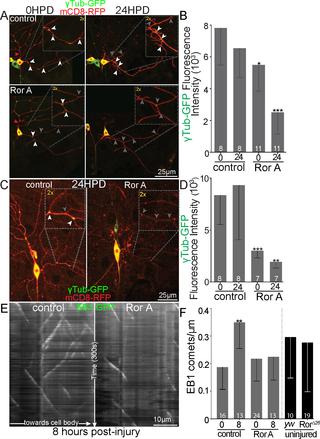PLOS Biology ( IF 7.8 ) Pub Date : 2020-03-12 , DOI: 10.1371/journal.pbio.3000657 Derek M R Nye 1, 2 , Richard M Albertson 1, 2 , Alexis T Weiner 1 , J Ian Hertzler 1 , Matthew Shorey 1 , Deborah C I Goberdhan 3 , Clive Wilson 3 , Kevin A Janes 4 , Melissa M Rolls 1

|
While many regulators of axon regeneration have been identified, very little is known about mechanisms that allow dendrites to regenerate after injury. Using a Drosophila model of dendrite regeneration, we performed a candidate screen of receptor tyrosine kinases (RTKs) and found a requirement for RTK-like orphan receptor (Ror). We confirmed that Ror was required for regeneration in two different neuron types using RNA interference (RNAi) and mutants. Ror was not required for axon regeneration or normal dendrite development, suggesting a specific role in dendrite regeneration. Ror can act as a Wnt coreceptor with frizzleds (fzs) in other contexts, so we tested the involvement of Wnt signaling proteins in dendrite regeneration. We found that knockdown of fz, dishevelled (dsh), Axin, and gilgamesh (gish) also reduced dendrite regeneration. Moreover, Ror was required to position dsh and Axin in dendrites. We recently found that Wnt signaling proteins, including dsh and Axin, localize microtubule nucleation machinery in dendrites. We therefore hypothesized that Ror may act by regulating microtubule nucleation at baseline and during dendrite regeneration. Consistent with this hypothesis, localization of the core nucleation protein γTubulin was reduced in Ror RNAi neurons, and this effect was strongest during dendrite regeneration. In addition, dendrite regeneration was sensitive to partial reduction of γTubulin. We conclude that Ror promotes dendrite regeneration as part of a Wnt signaling pathway that regulates dendritic microtubule nucleation.
中文翻译:

受体酪氨酸激酶Ror是果蝇神经元树突再生所必需的。
虽然已经确定了许多轴突再生调节剂,但对于使树突在损伤后再生的机理了解甚少。使用果蝇在树突再生的模型中,我们对受体酪氨酸激酶(RTK)进行了候选筛选,并发现了对RTK样孤儿受体(Ror)的需求。我们证实Ror是使用RNA干扰(RNAi)和突变体在两种不同神经元类型中再生所必需的。轴突再生或正常枝晶发育不需要Ror,表明在枝晶再生中有特定作用。Ror可以在其他情况下充当带有毛躁(fzs)的Wnt共受体,因此我们测试了Wnt信号蛋白在树突再生中的参与。我们发现击倒fz,衣衫不整(dsh),Axin和gilgamesh(gish)也会减少枝晶再生。此外,需要Ror将dsh和Axin置于树突中。我们最近发现Wnt信号蛋白,包括dsh和Axin,将微管成核机制定位在树突中。因此,我们假设Ror可能通过在基线和树突再生过程中调节微管成核来发挥作用。与此假设相符,Ror RNAi神经元中核心成核蛋白γTubulin的定位减少,并且在树突再生期间这种作用最强。另外,枝晶再生对γ-调蛋白的部分还原敏感。我们得出结论,Ror促进树突再生,作为调节树突状微管成核的Wnt信号通路的一部分。在枝晶再生过程中这种作用最强。另外,枝晶再生对γ-调蛋白的部分还原敏感。我们得出结论,Ror促进树突再生,作为调节树突状微管成核的Wnt信号通路的一部分。在枝晶再生过程中这种作用最强。另外,枝晶再生对γ-调蛋白的部分还原敏感。我们得出结论,Ror促进树突再生,作为调节树突状微管成核的Wnt信号通路的一部分。









































 京公网安备 11010802027423号
京公网安备 11010802027423号